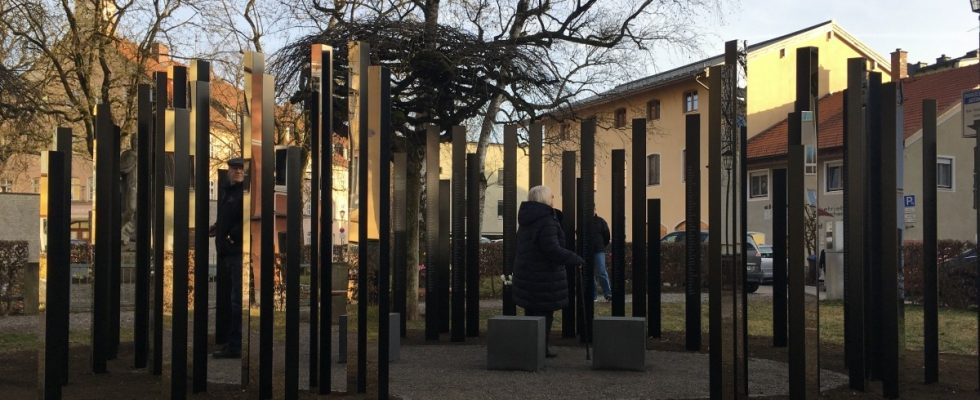A few years ago, the district of Upper Bavaria set itself the task of finally naming all the victims who were murdered in its facilities during National Socialism. In 2018 he published a “Memorial Book for the Munich Victims of the National Socialist ‘Euthanasia’ Murders” with the NS Documentation Center. Another book for the dead, also from the rest of Upper Bavaria, is to follow in three or four years, delayed by the death of the Munich medical historian Gerrit Hohendorf, who was also to play a key role in this second book. In the meantime, the district has published a work that reaches far beyond Upper Bavaria and that deals with these crimes of the Nazi era as a fundamental topic. Even the title – “Displaced” – points to how much still needs to be done today and will still be done tomorrow.
The subtitle and the entire 256-page book show that it is not easy to name the crime by its name in addition to the dead. The word “euthanasia” is consistently in quotation marks. The word “good death” taken from ancient Greek is the language of the perpetrators. It is the word that the National Socialists themselves chose for their murders of the sick and disabled. But “Krankenmorde”, as it was called in the working title of the book, would probably not have been better from Jörg Skribeleit’s point of view. Because by far not all those murdered would be described as sick according to today’s view, says Skribeleit, who heads the Flossenbürg concentration camp memorial in the Upper Palatinate and since 2020 also the newly established Center for Remembrance Culture at the University of Regensburg. The book that Skribeleit is responsible for together with Winfried Helm is also the first independent publication of this center.
This book also mentions names. Those of Helmut Silberberg, Josefa Rott, Anton Widhammer, Josef Schneller, Katharina Schwaiger and Wilhelm von Bibra, for example. They were all patients of the former Upper Bavarian Eglfing-Haar sanatorium and nursing home near Munich, and they were all murdered by the Nazis, who labeled their lives as unworthy and wanted to prevent “hereditary offspring” by murdering them, as the relevant law of the July 14, 1933. Two pages of text are dedicated to each of these six exemplary dead, and before that a reproduction of the cover sheet of their medical records.
Those files still exist. The district of Upper Bavaria, which today supports the Isar-Amper-Klinikum in Haar, has kept them and many others in its archive, which District President Josef Mederer (CSU) calls “our treasure”. Because in contrast to many other bodies, it has archived the files over the decades and has now made them very well accessible, instead of eliminating them and thereby erasing the memory of what happened as much as possible. In this way, the possibility of remembering remained at least preserved in very specific cases in which people in need of protection were forcibly sterilized, in which they were deliberately allowed to starve or taken to gas murder institutions such as in Hartheim in Upper Austria, in Hadamar in Hesse, in Grafeneck in Baden-Württemberg, in Bernburg in Saxony-Anhalt, in Brandenburg an der Havel or in Pirna-Sonnenstein in Saxony.
Historian Jörg Skriebeleit (left) and Upper Bavaria’s District President Josef Mederer (CSU) at the presentation of the book.
(Photo: Matthias Köpf)
All of these places are listed in the book on a map of the “Greater German Reich” in 1942 and its annexed areas to the east, along with dozens more where people were not gassed according to plan but murdered in other ways – decided, ordered, instructed and at least tolerated not only by Nazi cadres and loyal bureaucrats of the Nazi dictatorship, but also by doctors, nurses and nurses in all the homes, hospitals and institutions themselves. For example, there was no gas murder facility on Bavarian soil, and yet it is appreciated Jörg Skribeleit put the number of victims in Bavaria at 25,000 to 30,000 and, including those who had been sterilized, many more.
What happened then, how it has been dealt with since then, how it is dealt with today and how it could be dealt with in the future – these are the topics of the complex and varied book, on which more than 20 authors have contributed.
Repressed. The memory of the National Socialist “euthanasia” murders. Published by the district of Upper Bavaria by the Center for Remembrance Culture at the University of Regensburg (Jörg Skriebeleit and Winfried Helm), 256 pages, 200 illustrations, ISBN 978-3-8353-5374-9, 24.90 euros.

